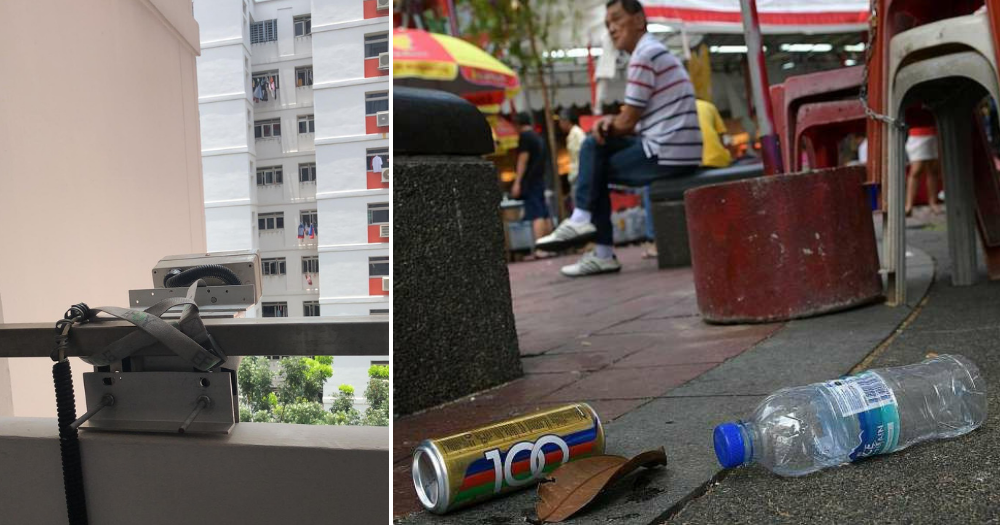A killer litter case recently made headlines in Singapore, after a glass bottle believed to have been thrown out of the window of a condominium in Outram, struck the head of a 73-year-old man at the BBQ pit area.
The man subsequently died in hospital on Aug. 18, 2019.
Police then went door-to-door to collect fingerprints.
A suspect has since been arrested and charged in court.
Surveillance cameras help catch litterbugs
Littering was one of the many topics raised by several ministers, during a Sept. 3 Parliament sitting.
In response to the questions, Senior Minister of State for Environment and Water Resources Amy Khor revealed that in 2018 alone, around 26,000 reports of littering were received by the National Environment Agency (NEA).
Meanwhile in the same year, NEA took around 39,000 enforcement actions against littering in public places.
For high-rise littering in particular, over 7,700 reports were made between 2016 and 2018.
Over the years, the numbers reportedly remained relatively stable each year, hovering around 2,300 and 2,800 reports.
To catch more litterbugs red-handed, NEA has installed surveillance cameras with video analytics since 2012.
The cameras have reportedly "contributed significantly" to enforcement actions.
Between August 2012 and December 2018, over 2,200 offenders were caught for high-rise littering.
Out of the lot, 52 were repeat offenders.
Catching culprits is a long and detailed process
Khor clarified that enforcement action against litterbugs is only carried out when there is substantial evidence.
NEA first assesses whether there are enough leads from the original report or feedback, before investigating further.
To identify the offender and confirm culpability, interviews with witnesses and suspects, as well as stakeouts and patrols will be conducted.
Cameras might also be deployed for monitoring.
The entire process from initial feedback to catching of the culprit reportedly takes between 10 weeks and six months, depending on the complexity of the case.
Stiff penalties for high-rise littering
There exist various channels for members of the public to report cases of high-rise littering.
They can call NEA's hotline, or submit information and other evidence, such as photos or videos via the MyENV mobile app.
To deter such activities, litterbugs caught will suffer stiff penalties.
First-time offenders can be fined up to S$2,000 for each offence, while repeat offenders can be fined up to S$10,000 or face a Corrective Work Order (CWO) in addition to, or in lieu of, a fine upon conviction.
In 2018, 2,600 CWOs were issued.
To further discourage litterbugs, the CWO vests that offenders have to wear have been swapped out in May for newer luminous pink and yellow ones.
Education still key
Education to increase awareness of littering is still key, Khor reiterated.
Although laws exist to deter litterbugs, "it is more important that we foster collective responsibility for our environment and cultivate positive social norms."
The Keep Singapore Clean movement by NEA, the Public Hygiene Council and other partners is still well underway to inculcate the right habits amongst Singaporeans.
Education outreach efforts reportedly helps caution residents against littering, and prevents the number of littering incidents from rising.
Khor added that significant resources are devoted to a wide range of stakeholders such as schools, residents, private and public organisations, and even foreign workers.
These individuals do conduct ground-up activities to keep the environment clean, such as litter-picking activities, and beach and park clean-ups.
To support this growing movement, several CleanPods were set up at Bishan-Ang Mo Kio Park, Pasir Ris Park and East Coast Park in July this year.
These storage rooms contain a host of litter-picking tools free and available for public use.
Khor said:
"The government will continue with our efforts to develop greater environmental stewardship, but we cannot do it alone. Every one of us must do our part to keep Singapore a clean, green, and sustainable home for our future generations."
Top photo from Wael Attia/ FB and @realitydreamzxc/ Twitter
If you like what you read, follow us on Facebook, Instagram, Twitter and Telegram to get the latest updates.
